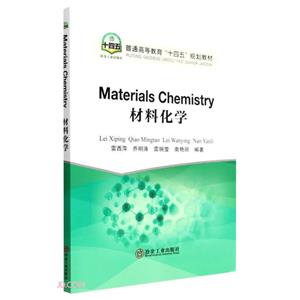扫一扫
关注中图网
官方微博
本类五星书更多>
-
>
湖南省志(1978-2002)?铁路志
-
>
公路车宝典(ZINN的公路车维修与保养秘籍)
-
>
晶体管电路设计(下)
-
>
基于个性化设计策略的智能交通系统关键技术
-
>
德国克虏伯与晚清火:贸易与仿制模式下的技术转移
-
>
花样百出:贵州少数民族图案填色
-
>
识木:全球220种木材图鉴
材料化学 版权信息
- ISBN:9787502492298
- 条形码:9787502492298 ; 978-7-5024-9229-8
- 装帧:一般胶版纸
- 册数:暂无
- 重量:暂无
- 所属分类:>
材料化学 内容简介
本书包括三个部分:**部分是基础理论(第1~3章),介绍了晶体学、物理化学和高分子化学的基本概念和原理。第二部分是材料的应用(第4~7章)。介绍了金属材料、无机非金属材料和有机高分子材料的基本特性和制备方法,并结合作者的科研成果给出了实例。第三部分是材料防护(第八章),介绍了各种材料的腐蚀现象及防护措施。 本书可作为高校材料化学专业、材料科学与工程专业的教材,也可作为相关专业技术人员的参考。
材料化学 目录
Chapter 1 Foundation of Materials Science
1.2 Crystal Structures
1.1.1 Unit Cells
1.1.2 Crystal Systems
1.2 Crystalline and Nanocrystalline Materials
1.2.1 Single Crystals
1.2.2 Polycrystalline Materials
1.2.3 Anisotropy
1.2.4 Noncrystalline Solids
1.3 Defects
1.3.1 Point Defect
1.3.2 Linear Defects
1.3.3 Interfacial Defects
Questions
References
Chapter 2 Foundation of Physical Chemistry
2.1 Thermodynamic Laws
2.1.1 The First Law of Thermodynamics
2.1.2 The Second Law and the Third Law of Thermodynamics
2.2 Chemical Reaction Kinetics
2.2.1 Chemical Reaction and Rate Law
2.2.2 The Integral form of the Reaction Rate Equation
2.2.3 Linking the Rate Laws with Reaction Mechanisms
2.3 Electrochemical Foundation
2.3.1 Electrolyte Solution
2.3.2 Electrolyte System
2.3.3 Nernst Equation
2.3.4 The Electrochemical Reaction Rate
Questions
References
Chapter 3 Foundation of Polymer Materials
3.1 Introduction of Polymer
3.2 Classification of Polymers
3.2.1 Classification by Source
3.2.2 Classification by Application
3.2.3 Classification by Chain Structure
3.2.4 Classification by Thermal Behavior
3.2.5 Classification by Polymerization
3.2.6 Classification by Elemental Composition of Main Chain
3.3 Chain Structure and Condensed Structure
3.4 Glass Transition
Questions
References
Chapter 4 Preparation Principles in Materials Chemistry
4.1 Features of Basic Material
4.1.1 Metals
4.1.2 Ceramics
4.1.3 Polymeric Materials
4.1.4 Materials Design and Selection
4.2 Solid State Reaction
4.2.1 Definition and Features
4.2.2 Solid-solid Interface
4.3 Liquid State Reaction
4.3.1 Ostwald Ripening
4.3.2 Crystal Nucleation and Growth
4.4 Gas State Reaction
4.4.1 Vapor Absorption and Adsorption
4.4.2 Chemical Vapor Deposition (CVD)
4.4.3 Atomic Layer Deposition (ALD)
Questions
References
Chapter 5 Preparation Methods of Metal
5.1 Chemical and Photochemical Synthesis
5.1.1 Light Mediated Synthesis
5.1.2 Electrolysis and Pyrolysis
5.1.3 Citrate Reduction
5.1.4 Polyol Synthesis
5.1.5 Seed Mediated Synthesis
5.2 Soft and Hard Template Mediated Synthesis
5.3 Hydrothermal Process
Questions
References
Chapter 6 Preparation Methods of Inorganic Nonmetallic Material ..
6.1 Preparation Methods of Inorganic Powders
6.1.1 Co-precipitation and Precursor Methods
6.1.2 The Sol-gel Method
6.1.3 Hydrothermal and Solvothermal Methods
6.1.4 Molten Salts
6.1.5 Combustion Synthesis
6.2 Molding Process of Inorganic Materials
6.2.1 Fabrication and Processing of Glasses
6.2.2 Powder Processing
6.2.3 Tape Casting
Questions
References
Chapter 7 Preparation Mechanisms of Polymer
7.1 Radical Chain Polymerization
7.1.1 Sequence of Radical Chain Polymerization
7.1.2 Kinetics of Initiation and Polymerization
7.2 Step-growth Polymerization
7.2.1 Self-catalyzed Polymerization
7.2.2 Molecular Weight of Polymer
7.3 Polymerization Processes
Questions
References
Chapter 8 Corrosion and Protection of Materials
8.1 Electrochemical Considerations
8.1.1 Electrode Potentials
8.1.2 The Standard EMF Series
8.1.3 The Galvanic Series
8.1.4 Corrosion Rates
8.2 Forms of Corrosion
8.2.1 Uniform Attack
8.2.2 Galvanic Corrosion
8.2.3 Crevice Corrosion
8.2.4 Pitting
8.2.5 Intergranular Corrosion
8.2.6 Erosion-corrosion
8.2.7 Stress Corrosion
8.2.8 Hydrogen Embrittlement
8.3 Protection Principles and Ways
8.3.1 Cathodic Protection
8.3.2 Anodic Protection
8.3.3 Corrosion Protection by Coatings
8.3.4 Change of Environment
8.3.5 Proper Design
Questio
1.2 Crystal Structures
1.1.1 Unit Cells
1.1.2 Crystal Systems
1.2 Crystalline and Nanocrystalline Materials
1.2.1 Single Crystals
1.2.2 Polycrystalline Materials
1.2.3 Anisotropy
1.2.4 Noncrystalline Solids
1.3 Defects
1.3.1 Point Defect
1.3.2 Linear Defects
1.3.3 Interfacial Defects
Questions
References
Chapter 2 Foundation of Physical Chemistry
2.1 Thermodynamic Laws
2.1.1 The First Law of Thermodynamics
2.1.2 The Second Law and the Third Law of Thermodynamics
2.2 Chemical Reaction Kinetics
2.2.1 Chemical Reaction and Rate Law
2.2.2 The Integral form of the Reaction Rate Equation
2.2.3 Linking the Rate Laws with Reaction Mechanisms
2.3 Electrochemical Foundation
2.3.1 Electrolyte Solution
2.3.2 Electrolyte System
2.3.3 Nernst Equation
2.3.4 The Electrochemical Reaction Rate
Questions
References
Chapter 3 Foundation of Polymer Materials
3.1 Introduction of Polymer
3.2 Classification of Polymers
3.2.1 Classification by Source
3.2.2 Classification by Application
3.2.3 Classification by Chain Structure
3.2.4 Classification by Thermal Behavior
3.2.5 Classification by Polymerization
3.2.6 Classification by Elemental Composition of Main Chain
3.3 Chain Structure and Condensed Structure
3.4 Glass Transition
Questions
References
Chapter 4 Preparation Principles in Materials Chemistry
4.1 Features of Basic Material
4.1.1 Metals
4.1.2 Ceramics
4.1.3 Polymeric Materials
4.1.4 Materials Design and Selection
4.2 Solid State Reaction
4.2.1 Definition and Features
4.2.2 Solid-solid Interface
4.3 Liquid State Reaction
4.3.1 Ostwald Ripening
4.3.2 Crystal Nucleation and Growth
4.4 Gas State Reaction
4.4.1 Vapor Absorption and Adsorption
4.4.2 Chemical Vapor Deposition (CVD)
4.4.3 Atomic Layer Deposition (ALD)
Questions
References
Chapter 5 Preparation Methods of Metal
5.1 Chemical and Photochemical Synthesis
5.1.1 Light Mediated Synthesis
5.1.2 Electrolysis and Pyrolysis
5.1.3 Citrate Reduction
5.1.4 Polyol Synthesis
5.1.5 Seed Mediated Synthesis
5.2 Soft and Hard Template Mediated Synthesis
5.3 Hydrothermal Process
Questions
References
Chapter 6 Preparation Methods of Inorganic Nonmetallic Material ..
6.1 Preparation Methods of Inorganic Powders
6.1.1 Co-precipitation and Precursor Methods
6.1.2 The Sol-gel Method
6.1.3 Hydrothermal and Solvothermal Methods
6.1.4 Molten Salts
6.1.5 Combustion Synthesis
6.2 Molding Process of Inorganic Materials
6.2.1 Fabrication and Processing of Glasses
6.2.2 Powder Processing
6.2.3 Tape Casting
Questions
References
Chapter 7 Preparation Mechanisms of Polymer
7.1 Radical Chain Polymerization
7.1.1 Sequence of Radical Chain Polymerization
7.1.2 Kinetics of Initiation and Polymerization
7.2 Step-growth Polymerization
7.2.1 Self-catalyzed Polymerization
7.2.2 Molecular Weight of Polymer
7.3 Polymerization Processes
Questions
References
Chapter 8 Corrosion and Protection of Materials
8.1 Electrochemical Considerations
8.1.1 Electrode Potentials
8.1.2 The Standard EMF Series
8.1.3 The Galvanic Series
8.1.4 Corrosion Rates
8.2 Forms of Corrosion
8.2.1 Uniform Attack
8.2.2 Galvanic Corrosion
8.2.3 Crevice Corrosion
8.2.4 Pitting
8.2.5 Intergranular Corrosion
8.2.6 Erosion-corrosion
8.2.7 Stress Corrosion
8.2.8 Hydrogen Embrittlement
8.3 Protection Principles and Ways
8.3.1 Cathodic Protection
8.3.2 Anodic Protection
8.3.3 Corrosion Protection by Coatings
8.3.4 Change of Environment
8.3.5 Proper Design
Questio
展开全部
书友推荐
- >
上帝之肋:男人的真实旅程
上帝之肋:男人的真实旅程
¥19.3¥35.0 - >
名家带你读鲁迅:故事新编
名家带你读鲁迅:故事新编
¥13.0¥26.0 - >
经典常谈
经典常谈
¥12.7¥39.8 - >
大红狗在马戏团-大红狗克里弗-助人
大红狗在马戏团-大红狗克里弗-助人
¥4.5¥10.0 - >
姑妈的宝刀
姑妈的宝刀
¥12.9¥30.0 - >
烟与镜
烟与镜
¥14.4¥48.0 - >
巴金-再思录
巴金-再思录
¥14.7¥46.0 - >
月亮与六便士
月亮与六便士
¥15.1¥42.0
本类畅销
-
黑科技驱动世界的100项技术
¥21.9¥69.8 -
黑科技:驱动世界的100项技术(八品)
¥21.9¥69.8 -
指火控弹道与射击诸元理论
¥38.7¥49 -
智能照明工程手册
¥29.9¥49.8 -
光电直读光谱分析技术与应用
¥38.7¥49 -
服务型制造
¥76.3¥109





















